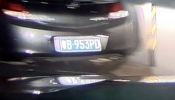- Joined
- Sep 29, 2015
- Messages
- 1,457
- Reaction score
- 3,358
- Location
- Shenzhen
- Country
- China
- Dash Cam
- A129 Pro / A129 Duo / A119 V3 / A119S / G1W-S / WR1/
Yes, just want to show how clearly the car license number.Probably a moving snapshot.
HDR is not like WDR.
HDR is supported by sensor, this require Novatek to implement it.
The sensor utilizes an advanced 2-micron OmniBSI-2™ pixel to provide best-in-class low-light sensitivity and high dynamic range (HDR).
Nice, good to see you are improving the firmware.
One question however, in the second picture you show a clear number plate but everything else in the picture is blurred? How come?
Yes, just want to show how clearly the car license number.
To avoid motion blur when moving fast you need enough light, most of the image did not have enough light, the plate did....
One question however, in the second picture you show a clear number plate but everything else in the picture is blurred? How come?
That's a good explanation. Notice how the plate reflection in the car bodywork is also sharp.To avoid motion blur when moving fast you need enough light, most of the image did not have enough light, the plate did.
The HDR consists of two separate exposures, a very fast one that has no motion blur but everything black unless it is in the direct beam of the headlights (the plate and a bit of the wall, followed by a normal frame with a slow exposure which is motion blurred all over and over exposed in the direct beam of the headlights. By adding the detail from the first frame to the second you get the final image. Most of it is motion blurred in both because the car is moving but the bit directly in front of the headlights, including the plate and a bit of the wall gets the detail from the first fast exposure with no motion blur, but there is not much from that frame, most of it was black except for the bits that where over exposed in the second frame.

That's a good explanation. Notice how the plate reflection in the car bodywork is also sharp.
View attachment 33553
That was some detailed photoshoppingThat's a good explanation. Notice how the plate reflection in the car bodywork is also sharp.
View attachment 33553
Viofo got the basics right with the camera first, and now they're looking to add HDR further down the line. Mobius tried to implement it from day one and consequently gave themselves a much bigger task. I agree the A119 HDR previews look really good.The Mobius M2 initially offered a very similar HDR feature that had impressive performance except that it created other imaging quality issues that couldn't be overcome, so it was eventually abandoned. Let's hope that the same thing doesn't happen here because these screen shots look really impressive and promising. Hopefully, the different hardware platform and SDK will be much more viable.
Viofo got the basics right with the camera first, and now they're looking to add HDR further down the line. Mobius tried to implement it from day one and consequently gave themselves a much bigger task. I agree the A119 HDR previews look really good.
Clearly not taking two similar exposures, one is much faster than the other.You make a good point and it may be difficult to draw a comparison for a variety of reasons. Still, I think the Mobius experience suggests there could potentially be some trade-offs. It would be interesting to see some daytime images from the HDR enabled A119. The Mobius HDR took advantage of the 60 fps capabilities of their camera by using two simultaneous 30 fps captures. I'm wonder if that is the same approach taken here?
Clearly not taking two similar exposures, one is much faster than the other.
There will always be some issues in merging the exposures but this looks like it has been done quite well and probably won't have much effect on daylight images.
The mini 0806 also had HDR where it took multiple exposures and merged them, but the multiple exposures were too similar and you frequently saw multiple ghost images from fast movement with a result that it was hard to say that it was any better overall than the Mobius. The A119 uses the same sensor as the 0806 but it looks like Novatek have done a better job than Amberella, and/or Viofo have done a better job than "mini".
| Thread starter | Similar threads | Forum | Replies | Date |
|---|---|---|---|---|
| B | Viofo A119 V2 Hardwire suddenly stopped working | A119 | 0 | |
|
|
A119 V2 gps mount pins bent, how to bend back to work again? | A119 | 11 | |
| V | Does A119 V2 have a rechargeable RTC battery? | A119 | 15 | |
|
|
A119 type with GPS/Traffic has horrible 2 Meter HAM radio noise! | A119 | 2 | |
|
|
Added: Support Image Rotation | A119 | 7 |
